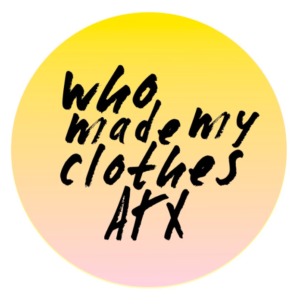This post was graciously sponsored by MiaDonna.
[/vc_column_text][vc_separator][vc_column_text]Me and marriage: you could call us frenemies. Despite what that lovely white dress would lead you to believe.I’ve entered that period in life when every other piece of mail is a save-the-date. I even caved and added The Knot to my bookmark tabs — an otherwise sacred place reserved for ethical brands I’m stalking or items I’ve hearted on Tradesy. Because, priorities!
As for my friends getting married, I’m happy for them, really. But I’m also a big ‘ole cynic of an institution that boxes in women, encourages us to blow our hard-earned money on a single day, and puts a veil (punny) over the grit it takes to sustain a marriage. The truth is, I’d rather spend my dough investing in a side gig that’s an extension of me or, hell, a dress I can wear more than once.
So, sorry catholic fam. First I lapsed and then I decided this sacrament wasn’t in my cards, at least not in a traditional sense. Given the ick factor a wedding incites, I steer clear of covering anything bridal, even the most ethical of stuff.
That is until I discovered diamonds that made my eyes twinkle like Audrey Hepburn. But they didn’t beckon me from Tiffany’s window. They reeled me in with information. Hey, a journalist here. That’s my jam. Diamonds are something that makes everyone take a second look and who could blame them, it is no wonder that people want to invest in them (Diamanten kaufen) they can potentially be quite lucrative if you know what you are doing.
They’re lab-grown stunners by MiaDonna and they opened my eyes to a world of ethics I didn’t know existed. Despite the fame of ‘Blood Diamond,’ the earth-mined diamond industry is still rife with human and environmental conflict. I talked to founder and CEO Anna-Mieke Anderson about how deep the structural issues run and how she’s changing the industry norm.[/vc_column_text][vc_single_image image=”3597″ img_size=”large” add_caption=”yes” alignment=”center”][vc_column_text]
Since I’m all about ethics here, I want to address the misunderstanding about blood and conflict diamonds, but first, let’s talk about the process of actually ‘growing’ a diamond. It’s fascinating! From what I’ve read, there are two methods you use, HPHT and CVD. Can you walk me through them?
Certainly. HPHT, which stands for high-pressure high-temperature, was the first method for growing diamonds in a lab. I find this super interesting…General Electric actually pioneered this method in 1954. During the process, carbon is crystallized into a diamond through intense – you guessed it – heat and pressure. Today, however, the technology for HPHT is outdated and it’s considered a slow and expensive process.
The CVD method (short for chemical vapor disposition) is a lot more common now as it works at moderate temperatures and low pressure. This method is more effective in producing higher quality, colorless diamonds. This is how it goes: a small diamond seed is placed in a low-pressure microwave chemical vapor deposition chamber. Then, gases combine with electrical energy, which ignites a plasma ball. A cloud forms in the chamber and carbon molecules rain on the seed. Within six to twelve weeks, a sizeable rough diamond is formed. After, it can be cut, polished and graded the same way as an earth-mined diamond.
By experimenting with this at MiaDonna we also discovered that changing the gases in the CVD chamber is how we produce different types and shades of diamonds that are so in vogue today. For instance, those stunning canary yellow and interesting pink shades.
Note from Kasi: Get into the chemistry more on this page.
Interesting. So are you using both processes at MiaDonna today?
When I started the company in 2005, we could only grow diamonds using the HPHT-process. At that time, they were yellow in color and under a quarter of a carat.
About 7 years later, we started to transition to CVD but we were blending the two methods. That changed in 2016, when a MiaDonna scientist created the world’s largest lab-grown diamond in the United States at 6.28 carats using a pure CVD method.
For us, this diamond represented a technological breakthrough. After years of research, we had developed a way to precisely replicate the earth’s natural process of crystallizing carbon into brilliant diamonds that are chemically, optically, and physically identical to earth-mined diamonds. And we do it at 30 to 50 percent of the cost. [/vc_column_text][vc_single_image image=”3595″ img_size=”large” add_caption=”yes” alignment=”center”][/vc_column][/vc_row][vc_row][vc_column][vc_column_text]
I saw you offer both “Diamond Hybrids ®” and traditional, lab-grown diamonds. What’s the difference?
The Hybrids are a diamond simulate and are not pure carbon like our lab-grown diamonds.
These exist because when I started out the technology to create lab-grown diamonds was still in its infancy and limited in application. For instance, we could only grow pure carbon diamonds to about 0.25ct in size and they turned out yellowish. I knew I couldn’t market theses and compete with conventional diamonds. But I was determined to offer something more ethical.
So we developed the Hybrid as a placeholder until the lab-grown technology was perfected. We call it this because it’s a blend of simulate and lab-grown technologies. Technically speaking, we construct the diamonds using a porous crystal core and infuse a lab-grown diamond on the outside.
Conversely, a lab-grown diamond is a pure carbon diamond, exactly the same as what you would get out of the earth but free of any negative humanitarian or environmental concerns.
Our lab-grown technology so closely mimic’s earth’s process that we can grow diamonds that match the beauty of ‘natural’ stones yet exceed them in ethics.
Is one more popular than the other?
Right now, our lab-grown diamonds are definitely surging in popularity. But even with the advances we still carry the Hybrids because they’re more accessible and that’s important to us as a company. We offer a range of price points so everyone can access a product that’s beautiful and conflict-free.
I hear that. The more we can make ethical choices approachable, the more widespread they will become. I noticed you’re also doing this is by using industry grading systems and terminology (carat, color, cut, clarity should ring a bell). That’s a smart move so the consumer has a familiar standard to inform their purchase.
Absolutely. We can do this because lab-grown diamonds are real diamonds; even though there’s still some misunderstanding about that fact. It’s like making ice in your freezer versus getting ice from a glacier. Both are chemically, physically and optically identical. One was just created in a mini lab (i.e. your freezer) and one was created by the earth. Same goes for our diamonds. That’s why we can grade them with the established 4C system. [/vc_column_text][/vc_column][/vc_row][vc_row][vc_column][vc_single_image image=”3594″ img_size=”large” add_caption=”yes” alignment=”center”][vc_column_text]
And how about the regulatory bodies that certify diamonds. Are they on board with the lab-grown method?
Most are. Our diamonds are graded by labs that have adopted this new technology, namely the IGI and EGLUSA. There are some like the GIA and AGA that adhere to more traditional methods and we’re still trying to make inroads with them. We’re also really encouraged by the world of GCal. We predict they’ll lead the pack in grading both lab-grown and earth-mined diamonds in the future.
You mentioned your stones match the quality of earth-mined stones, but side-by-side could I tell a difference?
Not at all. Lab-grown stones are indistinguishable from earth-mined equivalents, even under a microscope. The Gemological Institute of America backs us up on that claim.
The only difference is that one was grown underground, at great expense to the environment and human life, while the other was grown above the earth in a laboratory with near zero-impact on the environment and, most importantly, at no expense to human life.[/vc_column_text][vc_column_text]
It’s almost too good to be true. Lab-grown diamonds are made faster, cost less, are more ethical, and are higher quality than their counterparts*. So what the heck is holding everyone back from opting for them?
Right! That is what I am saying! In my experience, once a consumer is presented the facts and see the beauty of lab-grown diamonds, they nearly always go with them.
It’s all about awareness and that’s what we’re working really hard on today. There are a lot of people who just don’t know our technology exists. But that’s changing. I’ve seen the issues covered in the news more. They’re starting to talk about the environmental impact of mining and the ongoing blood wars and millennials are super tuned-in. They’re also turned off by how much a traditional diamond costs. That’s another big factor driving them toward us.
*MiaDonna’s diamonds are Type IIa, a harder, more-brilliant stone than Type 1a. Only 2% of earth-mined diamonds are Type IIa.
You mentioned ‘blood diamonds.’ I think most people know this term today (probably thanks to Leo) but your website says 70% of women still own earth-mined diamonds. So clearly, something isn’t working. Why aren’t the negative impacts more widely-known?
I agree, most people today do know what a ‘blood’ or ‘conflict’ diamond is, which is great! The issue I am seeing is that they think it is a problem of the past and it’s been resolved.
Unfortunately, that’s far from the reality. The diamond-mining industry is still plagued by violence and human rights violations. The blood diamond trade still exists, I have been there and seen it with my own eyes. In many African countries, rebel groups are notorious for killing, raping and torturing women, men, and children and enslaving them to work in the diamond mines. Over the past 6 years, it is estimated that 60 million carats of blood diamonds hit the international diamond market.
When Leo’s movie Blood Diamond came out, it presented the problem but not a solution.
So sales of earth-mined diamonds continued to increase. The industry masked the issue to consumers and hid behind The Kimberley Process Certification Scheme (KPCS), which is a rough diamond certification scheme to try to reduce the trade of conflict diamonds. It is widely known that a diamond is the hardest material on the planet, so it is also probably one of the hardest assets in the hard asset investment marketplace. Did you know the only thing that can scratch a diamond is itself? No wonder people strive for this beloved stone.
However, the issue with KPCS is that its definition is too narrow. It designates a ‘conflict-diamond’ as a “rough diamond mined in an area controlled by insurgent forces whose sale is used to finance anti-government military action.” This means that the diamonds mined, for example, in Zimbabwe which is notorious for killing, raping and maiming hundreds of artisanal miners are considered “conflict-free” under the KPCS. This is because, despite being mined under horrific conditions, they did not fund armed forces. These “dirty diamonds” are being certified by the Kimberley Process, making them “clean” and then sold to unassuming diamond consumers who think they are purchasing ‘conflict-free’ stones.
Today, the only way to ensure a diamond is conflict-free today is to go with a lab-grown option like ours.[/vc_column_text][/vc_column][/vc_row][vc_row][vc_column][vc_single_image image=”3592″ img_size=”large” add_caption=”yes” alignment=”center”][vc_column_text]
Wow – that’s absolutely shocking. And we’re still so into diamonds, especially from what I see in the US. I read we’re the world’s largest importer of diamonds. So are you mainly targeting US consumers?
Yes, over half of the world’s earth-mined diamonds end up in America. The US is our main market, but that’s also by default because we are based here. We’re definitely global as well. We have really strong markets in Australia, New Zealand, Canada and the UK.
Diverging a bit. Let’s talk about the modern state of romance, the future of weddings, and where MiaDonna fits. Personally, I sense a shift in the commercial wedding industry. A lot of my friends are eloping or opting for non-traditional weddings. Binary gender conventions are melting. How will these things impact your business?
I love this shift and I have been encouraging it for over a decade. We’re putting a modern twist on an antiquated industry and promise to continue being an advocate for diamond mining communities, global societies, and the earth.
At MiaDonna, we’re all about creating new traditions, not following them.
What’s the biggest challenge you face in trying to change a well-established industry?
Definitely the evolution of the competitive landscape. For instance, De Beers just announced they were entering the retail market for lab-grown diamonds. I’m really conflicted about this announcement.
Many people in the industry doubted the diamond juggernaut, which controls about 30 percent of the world’s supply of mined stones, would enter into this market, but I’ve kept a close eye on them for the last 10+ years as lab-grown as increased in popularity. I guessed they would jump on the bandwagon eventually. Because what do you do when your industry is threatened? You attempt to disrupt that threat.
I’m torn because their move validates the lab-grown diamond industry and signals that it’s too powerful to ignore. But on the other hand, leaders at the brand have openly bashed the product they are purportedly trying to sell. As Bruce Cleaver, De Beers’ CEO, told Bloomberg in an interview, “Lab-grown are not special, they’re not real, they’re not unique. You can make exactly the same one again and again.”
I also read he said this, “We’re not grading our lab-grown diamonds because we don’t think they deserve to be graded. They’re all the same.” Yuck.
Yep. It’s clear to me that their foray into law-grown diamonds isn’t about an ethical or sustainable solution to conflict diamonds. It’s about their bottom line and following something that’s become trendy.
We’ve been in the lab-grown business over 10 years. It’s my passion to transform the industry from the inside through MiaDonna. I hope this shows and I’m confident that consumers will be able to see through companies like De Beers, or any other overseas facilities selling lab-grown diamonds in unethical ways. Especially as we continue to share our message and create beautiful alternatives. [/vc_column_text][vc_separator][vc_column_text]Feature image by my gal Becky at Throwback Vintage. All other images, brand’s own.
[/vc_column_text][/vc_column][/vc_row][vc_row][vc_column][vc_column_text]Learn more about Blood Diamonds (also called war diamonds, red diamonds, or hot diamonds) in this CBS article. And tell us, would you buy a lab-grown diamond?[/vc_column_text][/vc_column][/vc_row]



